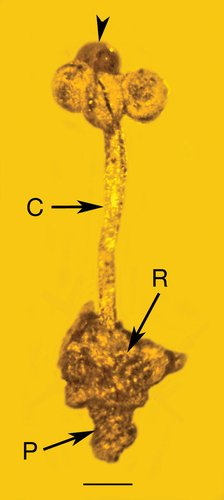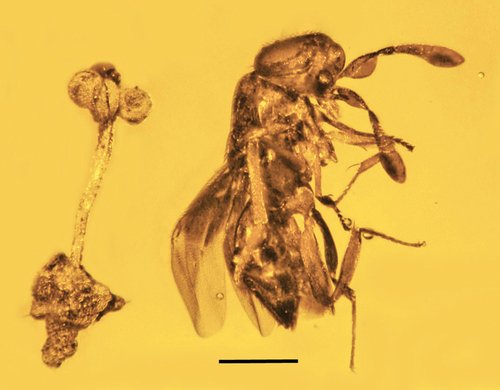In an immaculately preserved instance of prehistoric ecology, a recently discovered plant, a recently discovered wasp, and a developing fly larva have all been discovered imprisoned in amber.
You can thank the entomologist George Poinar, Jr., for the discovery of the image of an insect imprisoned in amber. His early research on insect DNA extraction from Dominican amber served as a direct inspiration for the plot of Jurassic Park.
- The Manhattan Project, the world’s first nuclear weapons test ve Widows of Village
- YouTube Creates Playlist of Videos with Over 1 Billion Views
His most recent research details the discovery of the plant genus Plukenetia in fossil form as well as its first occurrence on the Caribbean island of Hispaniola.
Members of this family’s fossilized flowers are extremely uncommon, according to Poinar. Only one previously discovered fossil, from sedimentary strata in Tennessee, could I find.
The renowned Dominican amber is a fossilized form of resin from the extinct Hymenaea protera tree. Based on the variety of living forms its resin entombed, scientists believe that this tree originally grew in a moist tropical forest setting.

The Cordillera Septentrional mountain range is where this specific specimen was mined.
There are opposing ideas regarding the age of Dominican amber fossils, and these theories are based on the microorganisms that were employed to date the specimens.
Foraminifera, single-celled protists sometimes known as “armored amoebae,” are thought by some to be a sign that the amber was produced between 20 and 15 million years ago.
Based on the presence of coccoliths, which are calcium carbonate plates created by the single-celled phytoplankton known as coccolithophores, some speculate that the time period was between 45 and 30 million years ago.
Poinar points out that the amber was tossed around and redeposited in turbulent sediment that later crystallized into rock, adding to the complexity of the situation. Additionally, identical amber specimens found in Jamaica and Puerto Rico have been dated to the Maastrichtian-Palaeocene (72.1-66 million years ago) and the Oligocene, respectively.
He places the age of this specimen at 30 million years.
The fossil not only exposes a novel plant species but also a whole ecological microcosm, which according to Poinar may have included parasitism, predation, and pollination.
It is true that small wasps fertilize contemporary members of the Euphorbia genus, which includes the living relatives of the fossilized plant, suggesting that this wasp may have had a similar ecological function.
The fossilized wasp, Hambletonia dominicana, was found and described by Poinar in 2020. It belongs to the parasitic encyrtid family of wasps, which are known for reproducing by placing their eggs or larvae alongside those of smaller insects, which the maturing young wasps then eat.
Poinar used high-resolution imaging to spot a tiny gall gnat (Cecidomyiidae) larva inside one of the flower’s developing seeds as well as the gnat’s damaged ovary capsule.
He speculates that the wasp may have been drawn to the diseased flower to lay an egg, which, once it hatched, would have quickly parasitized the gall gnat larva.
Naturally, the wasp’s cunning plan was foiled when a glob of sticky resin suddenly froze the three species in the arrangement they had been trapped in for millions of years.
Poinar was so moved by the beauty of this preserved moment that he linked the shapes of the flower’s “beautiful curves” and “long lines” to 20th-century art movements, while the wasp’s “dancing,” “decorative” shapes, and “sharp angles” reminded him of Art Deco architecture.
Everybody has their own method of perceiving the visual representations of the natural world, according to Poinar, depending on their interests, backgrounds, and current surroundings.
“An creature can be named scientifically, characterized, and then cataloged in a taxonomic hierarchy.”
Perhaps because it is so uncommon to find entire specimens, let alone ones that are such a blatant example of multispecies interaction, studies of fossils frequently concentrate on specific creatures and their positions in the evolutionary history of the tree of life.
According to Poinar, it happens frequently that unrelated organisms are accidentally entombed together in amber.
However, I believe that in this instance the wasp was drawn to the bloom either to collect nectar or in an effort to lay an egg on the capsule containing the fly larva.
Historical Biology published the article.





